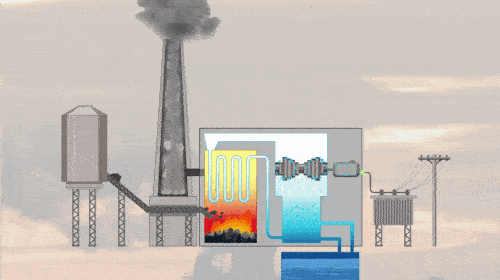
This animation shows how a thermal power plant generates electricity by converting heat energy into electrical energy.
Fuel is burned to produce heat, which turns water into steam. The steam drives a turbine connected to a generator, creating electrical power that is sent to homes and industries.
Key Components:
- Fuel Handling System: Stores and feeds coal (or another fuel) into the boiler.
- Boiler / Furnace: Burns the fuel to produce high-temperature heat.
- Steam Generator (Water Tubes): Heat turns water into high-pressure steam.
- Turbine: Steam rotates the turbine blades, converting heat energy into mechanical energy.
- Generator: Attached to the turbine; converts mechanical rotation into electricity.
- Cooling System: Condenses the used steam back into water using cool water from a lake, river, or cooling tower.
- Transformer: Steps up the generated voltage for transmission over long distances.
Working Principle:
- Fuel is burned in the boiler to produce heat.
- Heat converts water into high-pressure steam.
- Steam spins the turbine, creating rotational motion.
- The turbine drives the generator, producing electrical power.
- The steam is cooled, condensed, and recycled back to the boiler.
- Generated electricity flows through a step-up transformer to the power grid.
Thermal power plants are among the most common methods of large-scale electricity generation worldwide.
⚡ Tip:
Proper cooling and steam pressure control are essential for safe and efficient power generation.

